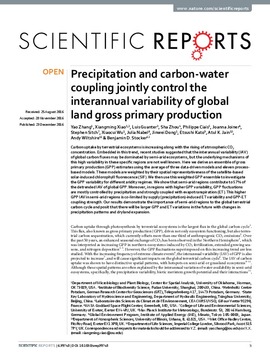| dc.creator | Zhang, Yao | |
| dc.creator | Xiao, Xiangming | |
| dc.creator | Guanter, Luis | |
| dc.creator | Zhou, Sha | |
| dc.creator | Ciais, Philippe | |
| dc.creator | Joiner, Joanna | |
| dc.creator | Sitch, Stephen | |
| dc.creator | Wu, Xiaocui | |
| dc.creator | Nabel, Julia | |
| dc.creator | Dong, Jinwei | |
| dc.creator | Kato, Etsushi | |
| dc.creator | Jain, Atul K. | |
| dc.creator | Wiltshire, Andy | |
| dc.creator | Stocker, Benjamin D. | |
| dc.date.accessioned | 2017-01-04T15:04:43Z | |
| dc.date.available | 2017-01-04T15:04:43Z | |
| dc.date.issued | 2016-12-23 | |
| dc.identifier.citation | Zhang, Y., Xiao, X., Guanter, L., Zhou, S., Ciais, P., Joiner, J., . . . Stocker, B. D. (2016). Precipitation and carbon-water coupling jointly control the interannual variability of global land gross primary production. Scientific Reports, 6, 39748. doi: 10.1038/srep39748 | en_US |
| dc.identifier.uri | https://hdl.handle.net/11244/47120 | |
| dc.description.abstract | Carbon uptake by terrestrial ecosystems is increasing along with the rising of atmospheric CO2 concentration. Embedded in this trend, recent studies suggested that the interannual variability (IAV) of global carbon fluxes may be dominated by semi-arid ecosystems, but the underlying mechanisms of this high variability in these specific regions are not well known. Here we derive an ensemble of gross primary production (GPP) estimates using the average of three data-driven models and eleven process-based models. These models are weighted by their spatial representativeness of the satellite-based solar-induced chlorophyll fluorescence (SIF). We then use this weighted GPP ensemble to investigate the GPP variability for different aridity regimes. We show that semi-arid regions contribute to 57% of the detrended IAV of global GPP. Moreover, in regions with higher GPP variability, GPP fluctuations are mostly controlled by precipitation and strongly coupled with evapotranspiration (ET). This higher GPP IAV in semi-arid regions is co-limited by supply (precipitation)-induced ET variability and GPP-ET coupling strength. Our results demonstrate the importance of semi-arid regions to the global terrestrial carbon cycle and posit that there will be larger GPP and ET variations in the future with changes in precipitation patterns and dryland expansion. | en_US |
| dc.description.sponsorship | This study by Y.Z., X.X., X.W., and J.D. is partially supported by a research grant (Project No. 2013-69002) through the USDA National Institute for Food and Agriculture (NIFA)‘s Agriculture and Food Research Initiative (AFRI), Regional Approaches for Adaptation to and Mitigation of Climate Variability and Change, and a research grant (IIA-1301789) from the National Science Foundation EPSCoR. | en_US |
| dc.format.extent | 9 pages | |
| dc.format.extent | 1,858,202 bytes | |
| dc.format.medium | application.pdf | |
| dc.language | en_US | en_US |
| dc.relation.requires | Adobe Acrobat Reader | |
| dc.rights | Attribution 3.0 United States | * |
| dc.rights.uri | https://creativecommons.org/licenses/by/3.0/us/ | * |
| dc.subject.lcsh | Carbon cycle (Biogeochemistry) | en_US |
| dc.subject.lcsh | Arid regions | en_US |
| dc.subject.lcsh | Evapotranspiration | en_US |
| dc.subject.lcsh | Precipitation variability | en_US |
| dc.title | Precipitation and carbon-water coupling jointly control the interannual variability of global land gross primary production | en_US |
| dc.type | Article | en_US |
| dc.type | text | |
| dc.description.peerreview | Yes | en_US |
| dc.identifier.doi | 10.1038/srep39748 | en_US |
| ou.group | College of Arts and Sciences::Department of Microbiology and Plant Biology | en_US |

